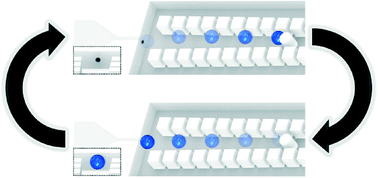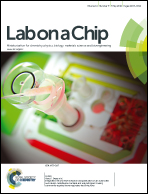Microfluidic bead-based diodes with targeted circular microchannels for low Reynolds number applications†
Abstract
Self-regulating fluidic components are critical to the advancement of microfluidic processors for chemical and biological applications, such as sample preparation on chip, point-of-care molecular diagnostics, and implantable drug delivery devices. Although researchers have developed a wide range of components to enable flow rectification in fluidic systems, engineering microfluidic diodes that function at the low Reynolds number (Re) flows and smaller scales of emerging micro/nanofluidic platforms has remained a considerable challenge. Recently, researchers have demonstrated microfluidic diodes that utilize high numbers of suspended microbeads as dynamic resistive elements; however, using spherical particles to block fluid flow through rectangular microchannels is inherently limited. To overcome this issue, here we present a single-layer microfluidic bead-based diode (18 μm in height) that uses a targeted circular-shaped microchannel for the docking of a single microbead (15 μm in diameter) to rectify fluid flow under low Re conditions. Three-dimensional simulations and experimental results revealed that adjusting the docking channel geometry and size to better match the suspended microbead greatly increased the diodicity (Di) performance. Arraying multiple bead-based diodes in parallel was found to adversely affect system efficacy, while arraying multiple diodes in series was observed to enhance device performance. In particular, systems consisting of four microfluidic bead-based diodes with targeted circular-shaped docking channels in series revealed average Di's ranging from 2.72 ± 0.41 to 10.21 ± 1.53 corresponding to Re varying from 0.1 to 0.6.


 Please wait while we load your content...
Please wait while we load your content...